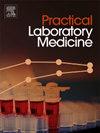Impact of using cross-over CV and mean for two different lots of assay control on implementation of Westgard rules in chemical diagnostic tests
IF 1.7
Q3 MEDICAL LABORATORY TECHNOLOGY
引用次数: 0
Abstract
Background
The main challenges of clinical laboratories concerning quality control include cost-effectiveness, variability in standardized materials, and evolving technologies across various diagnostic fields. While traditional QC practices and automation systems provide for accuracy, gaps exist, especially when applying Westgard rules to control lots for multiple assays. Such gaps result in inconsistent QC outcomes and unaddressed challenges in diagnostic reliability.
Objective
This study aims to assess the effect of the cross-over coefficient of variation (CV) and mean values for different assay control lots on implementing Westgard rules to improve QC practices and enhance the accuracy and reliability of diagnostic tests in molecular laboratories.
Methods
Data from 18 Levy-Jennings charts, with two assay control lots, were analyzed. Statistical comparisons of failure rates before and after setting the actual SD were performed using chi-square or T-tests at p < 0.05.
Results
The analysis of 18 Levy-Jennings charts showed a significant reduction in failure rates after establishing actual mean and SD values compared to cross-over CV. Of the charts, 11 exhibited differences in failure occurrences, particularly rejection failures, highlighting improved QC reliability.
Conclusion
These results emphasize the importance of accurate SD calculation in enhancing the effectiveness of Westgard rules. Therefore, establishing mean and SD values enhances QC reliability, reduces false failures, and ensures accurate Westgard rules application, while ongoing training in QC practices enhances diagnostic accuracy.
求助全文
约1分钟内获得全文
求助全文
来源期刊

Practical Laboratory Medicine
Health Professions-Radiological and Ultrasound Technology
CiteScore
3.50
自引率
0.00%
发文量
40
审稿时长
7 weeks
期刊介绍:
Practical Laboratory Medicine is a high-quality, peer-reviewed, international open-access journal publishing original research, new methods and critical evaluations, case reports and short papers in the fields of clinical chemistry and laboratory medicine. The objective of the journal is to provide practical information of immediate relevance to workers in clinical laboratories. The primary scope of the journal covers clinical chemistry, hematology, molecular biology and genetics relevant to laboratory medicine, microbiology, immunology, therapeutic drug monitoring and toxicology, laboratory management and informatics. We welcome papers which describe critical evaluations of biomarkers and their role in the diagnosis and treatment of clinically significant disease, validation of commercial and in-house IVD methods, method comparisons, interference reports, the development of new reagents and reference materials, reference range studies and regulatory compliance reports. Manuscripts describing the development of new methods applicable to laboratory medicine (including point-of-care testing) are particularly encouraged, even if preliminary or small scale.
 求助内容:
求助内容: 应助结果提醒方式:
应助结果提醒方式:


